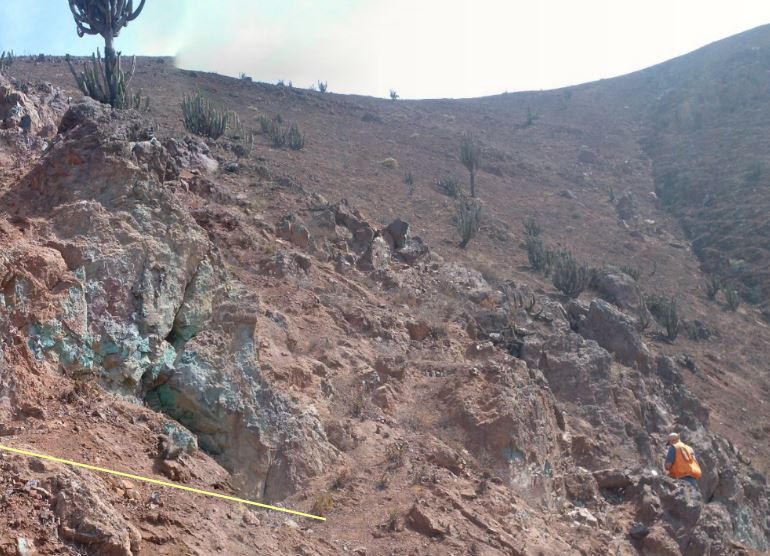Camino intersects 1.14% copper over 70.3 meters in southeast step out hole at Adriana

Katty out-crop
Camino Minerals Corporation (COR: TSX-V) is pleased to report results for the next five diamond drill holes completed on the Adriana Zone (“Adriana”) and two holes at the Katty Zone at its Los Chapitos Project, located in southern Peru.
Select drill highlights for the Adriana Zone include:
- DCH-033 intersected 1.14% copper over 70.3 meters, including 3.16% copper over 12.0 meters;
- DCH-036 intersected 0.76% copper over 91.0 meters, including 1.42% copper over 28.5 meters.
Drill holes DCH-033, DCH-035, and DCH-036 were drilled on Section 220 from Pad 4, an approximately 150 meter step out to the southeast from hole DCH-024, which intersected 1.31% copper over 82.5 meters, including 2.19% copper over 32.7 meters. All three holes intersected the high grade feeder zone as well as a near surface zone of stratigraphically controlled oxide copper and chalcocite mineralization. These results confirm that the diamond drilling at Adriana has intersected a substantial body of oxide and sulphide copper mineralization that currently measures over 400 meters long by 150 meters wide by 300 meters deep. The Adriana Zone is open at depth and in both directions along trend. In particular, several surface showings between the Adriana Zone and Katty Zone suggest good potential for expanding Adriana to the southeast towards Katty.
Two drills are currently working on the initial drill program at the Atajo Zone, located 6 kilometers to the southwest of Adriana. When that program has been completed, at least one of the drills will be mobilized back to Adriana to complete further step out drilling to the southeast towards the Katty Zone.
At Katty, two additional drill holes (DCH-037 and DCH-038) were completed which intersected the near surface oxide copper mineralization found in several of the previous drill holes. The surface mineralization at Katty is dominantly oxide copper which has been disrupted by post mineral dykes and faulting. The mineralization near the tops of the drill holes appears to be stratigraphically controlled, dipping to the southwest towards the projection of the Diva Fault. Additional drilling will be required to test for extensions of this mineralization.
Kenneth C. McNaughton, M.A.Sc., P.Eng., is the Qualified Person (QP) responsible for the Chapitos project.
Updated drill sections and summary presentation can be found on the company website at www.caminominerals.com.
Table 1: Selected Diamond Drill Results, (1,2)
| Hole
Number |
Pad #
Dip/Azimuth (degrees) |
From
(meters) |
To
(meters) |
Interval (meters) | Total Copper (%) |
Acid Soluble Copper (%) |
| Adriana Zone | ||||||
| DCH-033 | Pad 4 | 53.50 | 63.70 | 10.20 | 0.49 | 0.31 |
| -62.5/218 | 126.40 | 136.80 | 10.40 | 0.77 | 0.64 | |
| 291.40 | 307.90 | 16.50 | 0.18 | 0.11 | ||
| 316.00 | 386.30 | 70.30 | 1.14 | 0.21 | ||
| Incl. | 335.70 | 347.70 | 12.00 | 3.16 | 0.30 | |
| DCH-035 | Pad 4 | 118.50 | 145.50 | 27.00 | 0.37 | 0.33 |
| -52.5/218 | 258.00 | 298.50 | 40.50 | 0.82 | 0.14 | |
| Incl. | 270.50 | 273.30 | 2.80 | 4.26 | 0.20 | |
| DCH-036 | Pad 4 | 88.50 | 179.50 | 91.00 | 0.76 | 0.47 |
| Incl. | -45/218 | 133.00 | 161.50 | 28.50 | 1.42 | 0.70 |
| 271.00 | 281.70 | 10.70 | 0.48 | 0.03 | ||
| Incl. | 271.00 | 272.50 | 1.50 | 1.84 | 0.03 | |
| DCH-039 | Pad 2 | 121.90 | 125.00 | 3.10 | 0.94 | 0.56 |
| -75/140 | 153.50 | 169.00 | 15.50 | 0.82 | 0.69 | |
| DCH-040 | Pad 2 | 110.40 | 129.50 | 19.10 | 0.17 | 0.02 |
| -45/140 | 193.00 | 206.50 | 13.50 | 0.35 | 0.32 | |
| Katty Zone | ||||||
| DCH-037 | Kat 3, -45/60 | 13.90 | 18.50 | 4.60 | 1.93 | 1.28 |
| DCH-038 | Kat 3 | 4.10 | 14.00 | 9.90 | 0.41 | 0.32 |
| -90/60 | 19.70 | 26.00 | 6.30 | 0.29 | 0.14 | |
| 88.00 | 95.50 | 7.50 | 0.20 | 0.03 | ||
(1)True thickness to be determined.
(2)All samples were submitted for preparation and analysis by ALS Chemex at its facilities in Lima, Peru. All samples were analyzed using multi-digestion with ICP finish and select samples were analyzed for gold using fire assay with AA finish. Samples over 1% copper were reanalyzed using four acid digestion with an ore grade ICP finish.  Mineralized samples were analyzed for acid soluble copper by being agitated at room temperature in a 5% sulphuric acid solution with the copper content measured by AA.  One in 20 samples was blank, one in 20 was a standard sample, and one in 20 samples had a sample cut from assay rejects assayed as a field duplicate at ALS Chemex in Lima, Peru.
